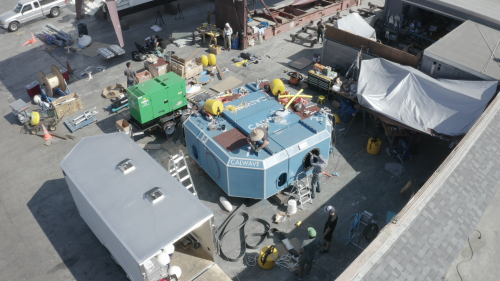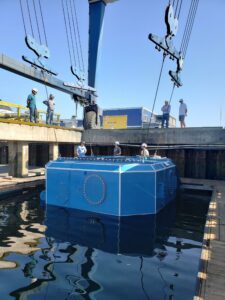CalWave: Harnessing Ocean Power for a Sustainable Future
CalWave Power Technologies, Inc., part of the Autodesk Research Residency Program, is advancing the renewable energy sector with its innovative approach to wave energy conversion. CalWave’s journey began with a unique inspiration: the concept of geomimicry. Unlike biomimicry, which emulates biological processes, geomimicry draws from geological phenomena. At the University of California, Berkeley’s Mechanical Engineering department in 2012, Marcus Lehmann, Co-Founder and CEO of, CalWave, was inspired by the natural vibrations of the ocean floor to extract energy. This idea led to the development of a membrane-like wave energy converter that operates submerged in the mid-water column, rather than on the surface. Lehmann and team built the proof-of-concept prototypes for his master’s thesis, which proved to be effective in extracting wave energy.
From Academia to Industry
This early success sparked the idea of commercializing the technology. However, the challenges were significant. “The fundamental challenge of wave energy is the delta between average production and peak design load,” explained Lehmann.
CalWave’s approach involves operating submerged and interacting with waves in the mid-water column, rather than on the surface. This method allows the system to dive and cut out peak loads during severe storms, addressing the challenge of balancing energy extraction during average conditions and withstanding peak loads during extreme weather events.
Through Cyclotron Road, a program focused on transitioning technologies from academic to commercial environments, CalWave was able to make significant strides. “Cyclotron Road allowed us to make these technological evolutions independent from an academic focus while still collaborating with UC Berkeley, which was extremely critical,” noted Lehmann.

In 2015, CalWave competed in and was awarded the highest performing system in the U.S. Wave Energy Prize , a competition run by the Department of Energy (DOE) to identify next-generation wave energy technologies. This achievement led to a multimillion-dollar demonstration contract from the DOE in 2017, allowing them to deploy an ocean-going unit.
CalWave’s next big leap came through its connection with the Autodesk Foundation. Initially, the company received in-kind software support, which later expanded to participation in the Residency Program. “Through Cyclotron Road, we got connected with the Autodesk Foundation, which led us to the Residency program,” explains Lehmann.
CalWave used a range of Autodesk software tools throughout different phases of its product development lifecycle. “We used Revit for GIS and spatial planning, CFD for hydrodynamic modeling, and a range of CAD and FEA tools for design and manufacturing,” Lehmann says. “Fusion has been particularly valuable for collaboration and project management. Fusion helped us with inventory, requirements management, and project management, which were critical for serial production and cost management.”
The Autodesk Technology Center in San Francisco also played a significant role in the fabrication of key components. “We built parts of the drivetrain in the machine shop through the Residency program. This capability to rapidly manufacture and adjust was super critical,” emphasized Lehmann.
Scaling Up for Commercial Impact
CalWave is now in the process of scaling up its technology to a 200-kilowatt commercial unit, with plans to produce 20 to 50 units per year. “We built an initial pilot unit and are now upscaling to a larger version for commercial roll out,” explained Lehmann. The company aims to transition from pilot projects to serial manufacturing, targeting isolated microgrids, offshore power, and co-location with offshore wind farms.
One of CalWave’s major milestones is its upcoming deployment at PacWave, the first grid-connected, full-scale wave energy test facility in the United States. CalWave is preparing to deploy its first commercial-scale unit, the x200, at PacWave in 2026, which is a significant step towards commercializing their technology and scaling up production. “PacWave is critical not just for us but for the industry as a whole. It removes the entire permitting and project risk, allowing us to fully test and certify our product,” said Lehmann.
Advocacy and Industry Leadership

Beyond technological advancements, CalWave is also actively involved in advocacy and industry leadership. The company is a member of the National Hydro Association’s Marine Energy Council and the Pacific Marine Energy Center. “We support efforts to secure funding for the Water Power Technology Office and have joined various initiatives to promote wave energy,” noted Lehmann.
CalWave’s advocacy work extends to legislative efforts as well. This comprehensive approach ensures that CalWave is not only advancing its technology but also shaping the future of the wave energy industry. “We signed an MOU with AltaSea and joined the California Wave and Tidal Energy Coalition, supporting a bill to investigate the potential of wave energy for the state of California,” said Lehmann.
The Future of CalWave
Looking ahead, CalWave is focused on deploying its commercial-scale unit at PacWave and moving into serial manufacturing. The company aims to be an Original Equipment Manufacturer (OEM), selling units and providing support services. “We plan to support owner-operators in their planning and installation, similar to the model used in the wind turbine industry,” said Lehmann.
The company is also exploring opportunities to address energy poverty in remote communities. CalWave is working with a First Nation community in British Columbia to help them gain energy independence. Reflecting on the journey, Lehmann said, “Our solution is ideal for coastal communities that have high local emissions by their diesel generators, lack of space and concerns about visual impact and storm survivability of other renewables.” Next to applications in isolated microgrids, CalWave targets to hybridize wind and wave farms increasing the overall output, while reducing cost .
Engage with CalWave at AU
Visit CalWave’s exhibit at AU 2024 to explore how they are shaping the renewable energy landscape. Attendees can see the wave technology up close, meet the team, and discover how they are advancing the future of sustainable energy. AU attendees can also join Lehmann’s theatre talk Unlocking the Future of Manufacturing on Thursday, October 17 from 12-1 PM.
- Stay up-to-date on CalWave’s work
- Learn more about the Autodesk Research Residency Program
Get in touch
Have we piqued your interest? Get in touch if you’d like to learn more about Autodesk Research, our projects, people, and potential collaboration opportunities
Contact us